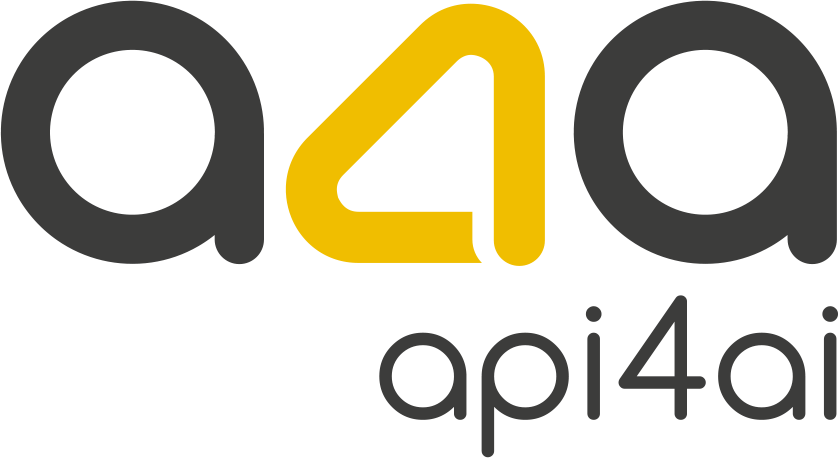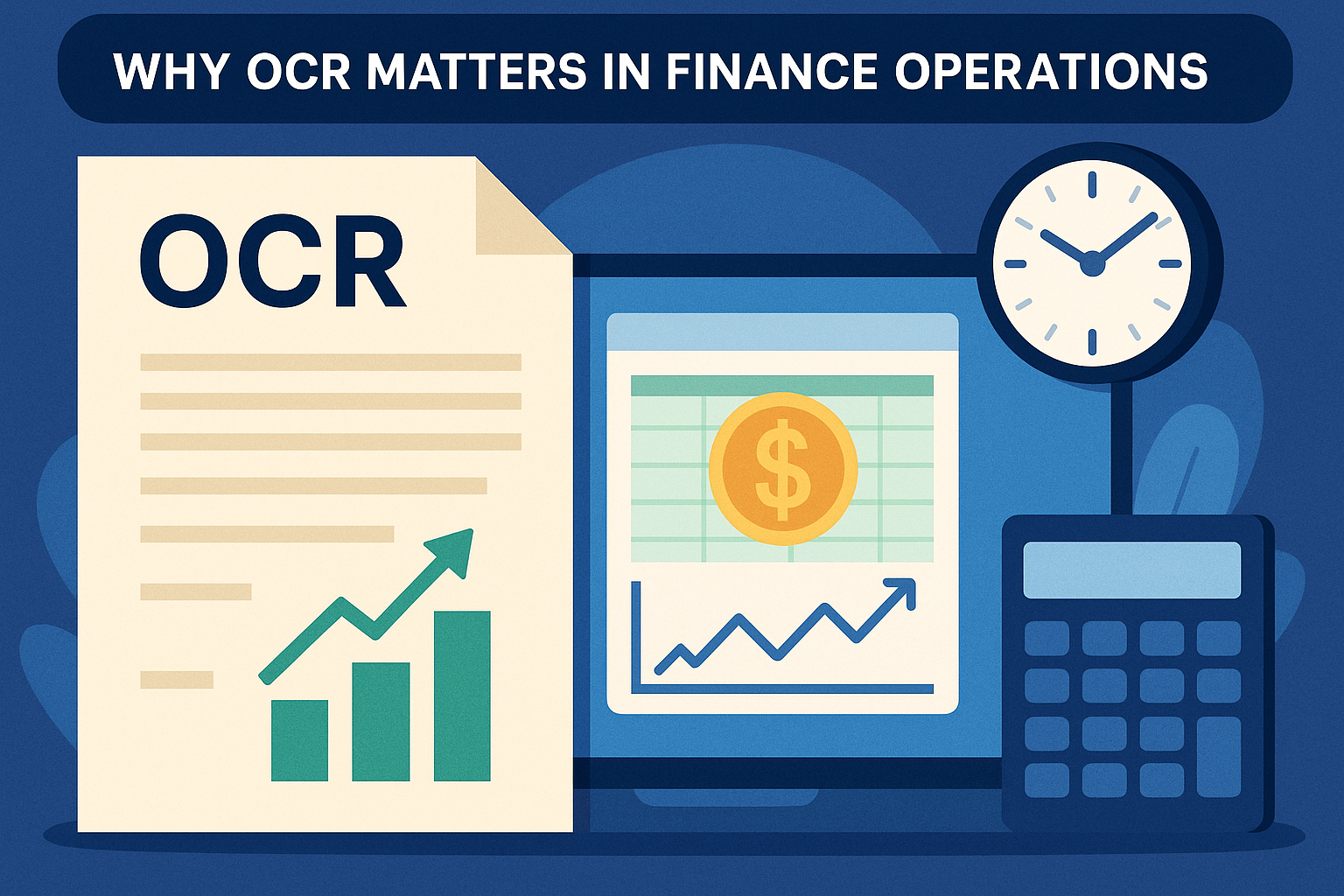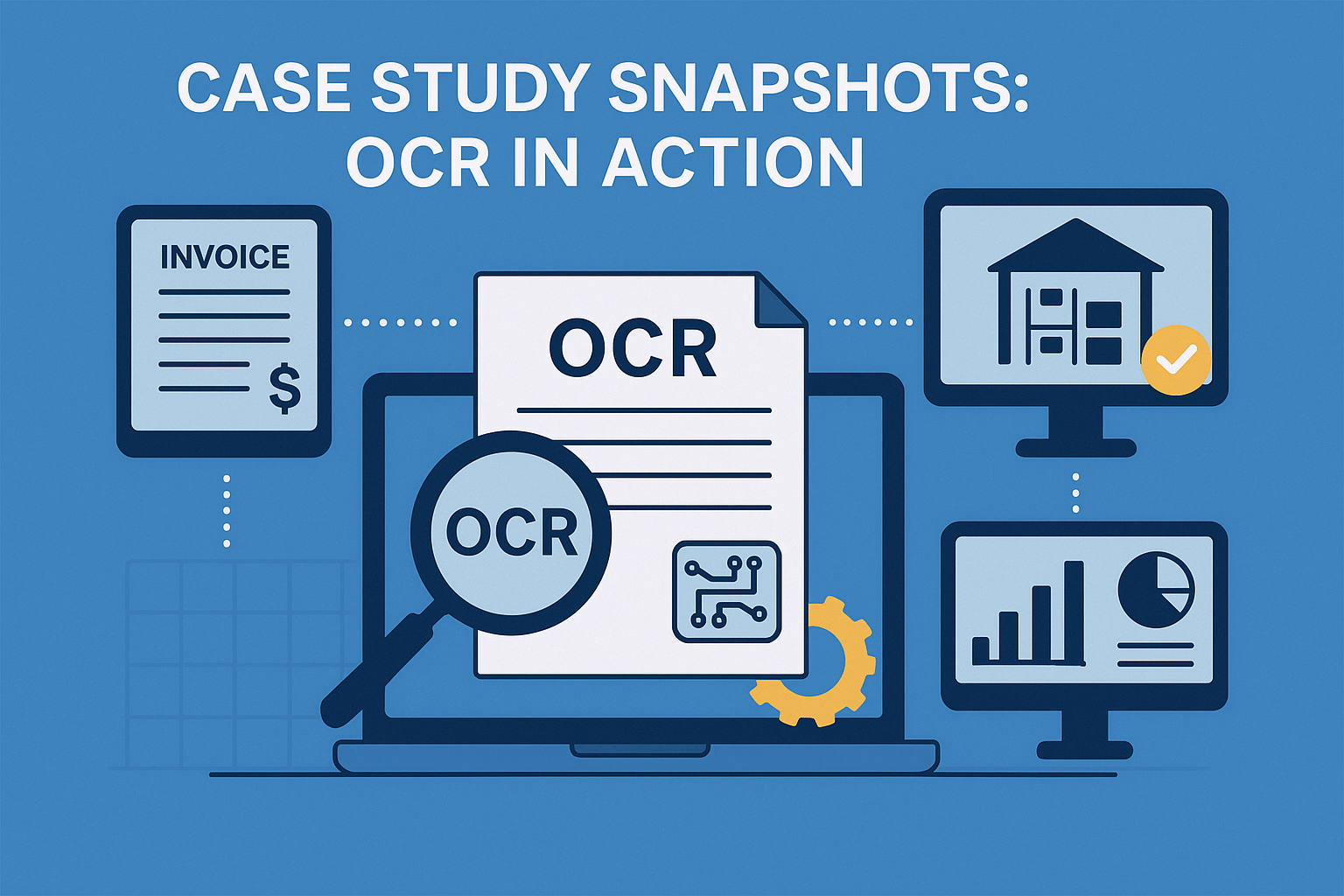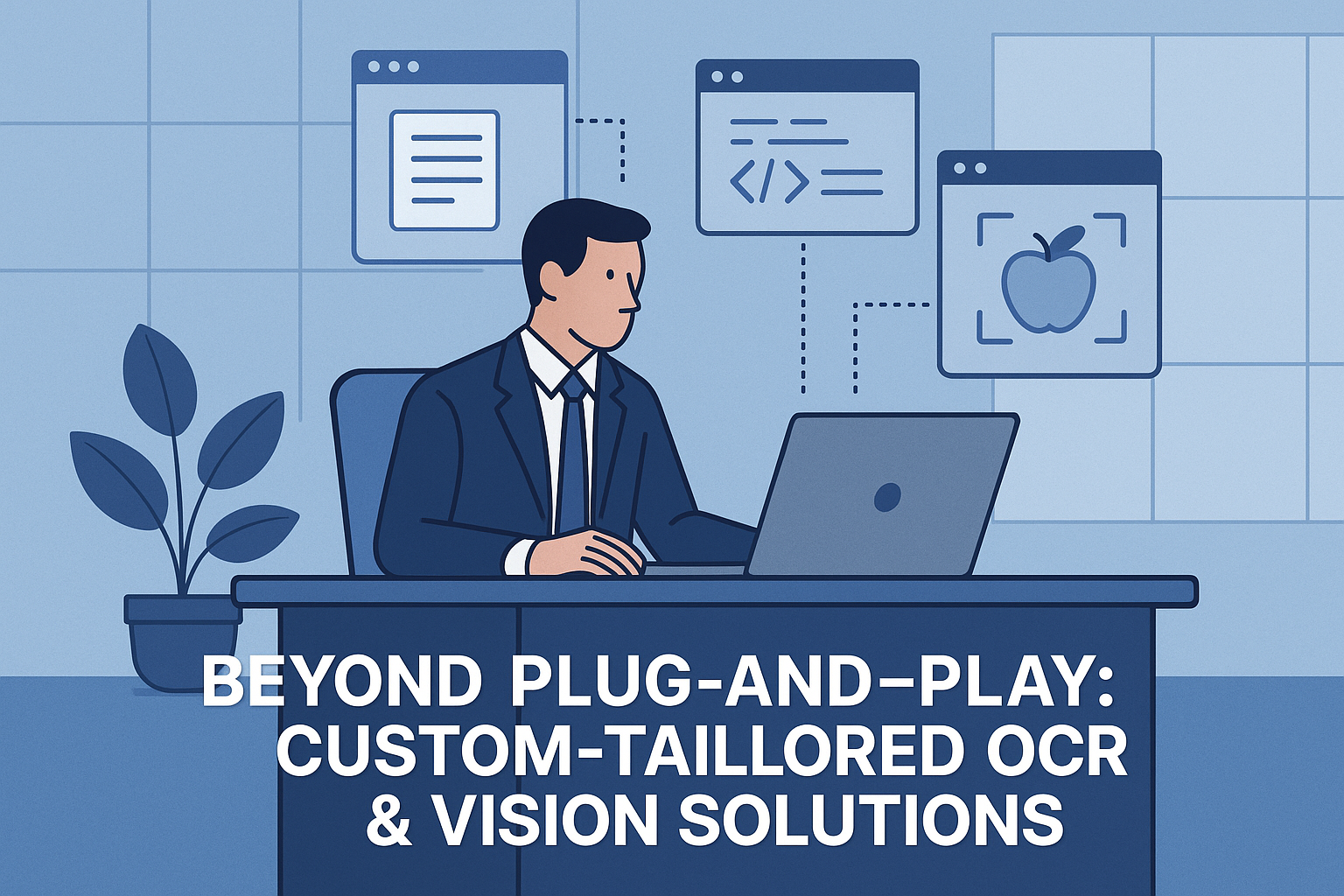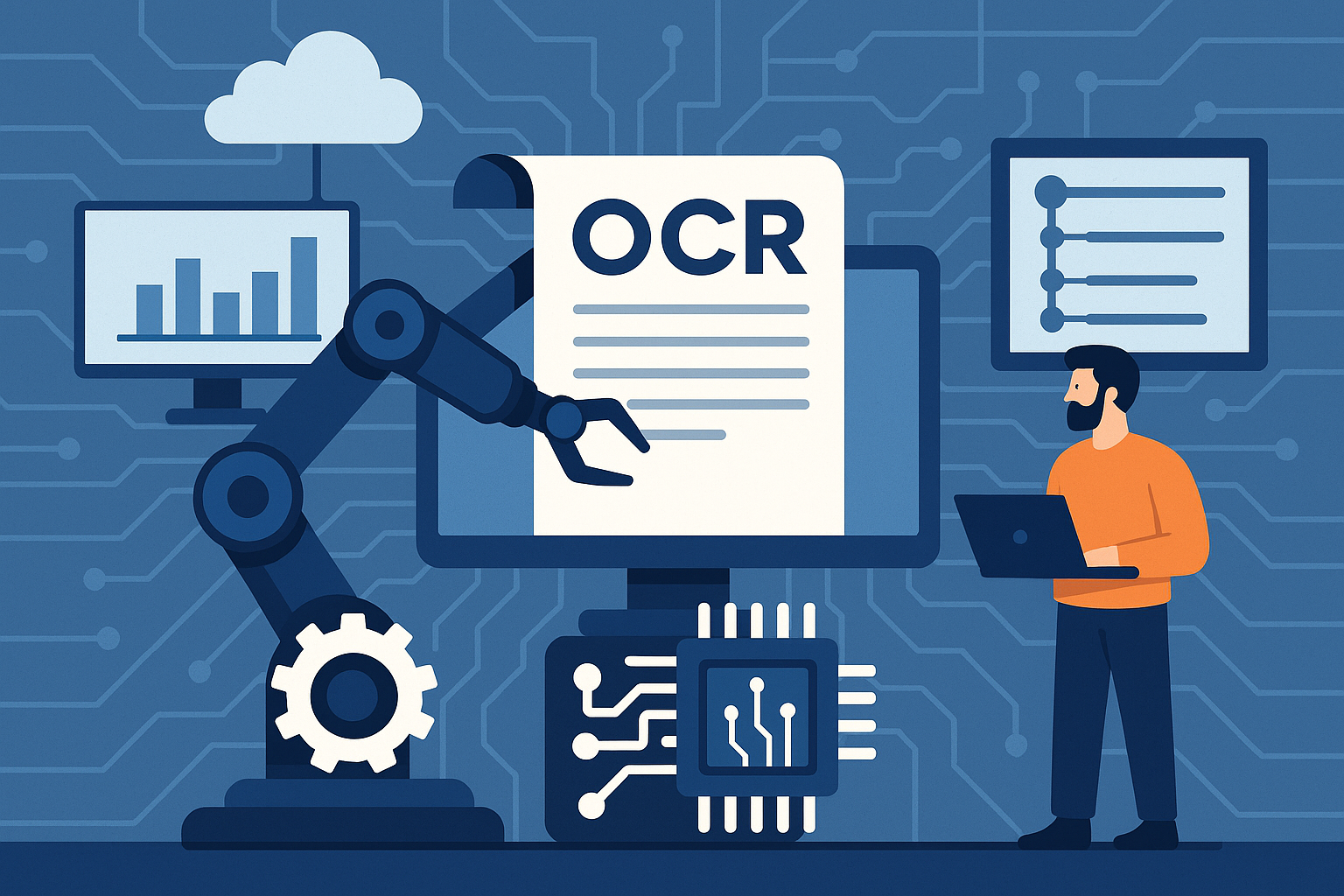OCR as a Differentiator in Digital Transformation Journeys
Introduction
In today’s enterprise landscape, digital transformation is no longer an optional initiative — it is the cornerstone of competitive survival. According to recent surveys, more than 71% of CFOs list digital transformation as their top priority, placing it even above cost control and compliance. The reason is simple: organizations that digitize workflows are achieving measurable performance gains. Automation in finance alone has been shown to deliver up to 85× faster processes and reduce error rates by as much as 90%, directly impacting bottom lines and risk management.
Yet, while executives often focus on artificial intelligence, robotic process automation, or data analytics as the headline technologies, one of the most powerful enablers frequently operates behind the scenes: Optical Character Recognition (OCR). OCR is the technology that transforms unstructured text locked in invoices, receipts, contracts, or scanned reports into structured, machine-readable data. Without it, many automation initiatives would stall at the first hurdle — extracting information accurately and at scale.
For senior leaders, this means that OCR is not just a tactical IT tool. It is a strategic differentiator in digital transformation journeys. By serving as the bridge between the physical and digital worlds of information, OCR allows finance teams to unlock efficiencies, accelerate reporting cycles, enhance compliance, and free talent for higher-value tasks. In practice, it often delivers one of the fastest returns on investment within the transformation portfolio.
This article explores the unsung but foundational role of OCR in finance and enterprise automation. Through case studies and forward-looking insights, we will demonstrate how OCR has quietly become the backbone of next-generation efficiency — enabling organizations to reduce costs, streamline operations, and secure a sustainable competitive advantage.
Context: CFOs Driving Digital Transformation
The role of the CFO has expanded far beyond financial stewardship. Today, finance leaders are often at the helm of enterprise-wide digital transformation, steering decisions that directly impact agility, resilience, and long-term competitiveness. Recent research highlights this shift: nearly seven out of ten CFOs are actively leading digital initiatives, with more than half already embedding artificial intelligence and automation into finance processes. What was once considered the domain of the CIO is now firmly part of the CFO’s strategic mandate.
The motivation is clear. Finance sits at the heart of the enterprise, touching every transaction, supplier, and stakeholder. Manual workflows — whether in accounts payable, expense management, or audit preparation — consume enormous resources while exposing organizations to errors, delays, and compliance risks. For executives under constant pressure to deliver speed, accuracy, and transparency, digital transformation is not about technology adoption for its own sake — it is about securing measurable performance improvements.
OCR becomes a critical enabler in this context. It empowers finance teams to convert high volumes of unstructured documents into immediately usable data, which can then flow into enterprise systems, analytics platforms, and decision-making dashboards. Without this foundational step, investments in automation, AI, or predictive analytics fail to reach their potential. CFOs who recognize this are not just adopting tools; they are building the infrastructure of a future-ready finance function.
What distinguishes leading CFOs is their ability to connect operational efficiency with strategic outcomes. Faster invoice processing leads to stronger supplier relationships. Real-time expense capture strengthens cash flow visibility. Automated compliance reporting reduces risk exposure. Each of these outcomes ties directly back to shareholder value — a language every executive understands.
For the C-Suite, the lesson is clear: digital transformation in finance is no longer a back-office upgrade; it is a boardroom-level differentiator. And within this transformation, OCR plays a pivotal role as the bridge between static documents and intelligent, automated workflows.
Why OCR Matters in Finance Operations
For many organizations, the largest barrier to true digital transformation is not the lack of advanced analytics or automation platforms — it is the persistence of unstructured, document-based data. Invoices, receipts, contracts, bank statements, and regulatory filings often arrive in formats that are difficult for machines to read but essential for business continuity. This is where Optical Character Recognition (OCR) becomes indispensable.
OCR is the technology that translates printed or handwritten text into structured, searchable, machine-readable data. While it may sound like a technical detail, for finance leaders it is nothing short of transformative. Without OCR, automation initiatives can only scratch the surface. With it, workflows become 85× faster, human error drops by up to 90%, and organizations gain the ability to process information in real time rather than in days or weeks.
Consider accounts payable as an example. A finance department processing thousands of invoices each month faces three common challenges: delays caused by manual entry, risk of error in data capture, and limited visibility into liabilities. By introducing OCR, invoices are digitized instantly, validated automatically, and integrated into enterprise resource planning (ERP) systems without manual intervention. The result is not only faster processing but also improved vendor relationships and stronger cash management.
The value extends beyond efficiency. For CFOs, OCR enhances compliance and audit readiness by ensuring documents are digitized with traceable accuracy, creating a verifiable record of every transaction. In an environment where regulatory oversight is intensifying, this capability significantly reduces the risk of penalties or reputational damage.
Equally important, OCR serves as a force multiplier for other transformation technologies. Machine learning models, robotic process automation (RPA), and predictive analytics all rely on structured, high-quality data. OCR ensures that data locked in static formats can feed these advanced systems, enabling organizations to move from reactive reporting to proactive decision-making.
For executives evaluating digital transformation investments, OCR represents a low-barrier, high-return capability. It is relatively simple to implement through ready-made APIs or integrated solutions, yet it unlocks measurable ROI within weeks. By laying this foundation, finance leaders position their organizations to scale into more sophisticated forms of automation and AI with confidence.
Case Study Snapshots: OCR in Action
The real value of OCR emerges most clearly when we look at how finance teams apply it in day-to-day operations. These examples demonstrate not only efficiency gains but also the strategic advantages that come from turning documents into actionable data.
1. Accelerating Invoice Processing
A multinational manufacturing firm faced delays in accounts payable, with invoices often taking up to five days to clear. By introducing OCR into its workflow, the company reduced processing time to less than 24 hours. This improvement translated into faster approvals, strengthened supplier relationships, and the ability to capture early-payment discounts — directly boosting working capital.
2. Reducing Errors in Expense Management
A global consulting organization struggled with inconsistent manual entry of employee expenses, leading to compliance risks and reimbursement disputes. By deploying OCR to automatically extract data from receipts submitted via mobile devices, the company reduced errors by over 85%. Finance staff were freed from verification tasks and redirected to higher-value financial planning activities.
3. Enhancing Compliance and Audit Readiness
A financial services provider preparing for regulatory audits faced the challenge of compiling thousands of client documents spread across disparate formats. OCR was used to digitize and categorize these records, creating a centralized, searchable archive. Audit preparation time dropped from weeks to days, and regulators praised the company’s improved transparency and traceability.
4. Unlocking Real-Time Insights
In a retail chain, executives lacked visibility into daily sales contracts and vendor agreements, which often arrived as scanned PDFs. By using OCR integrated with analytics dashboards, management gained same-day visibility into liabilities and obligations. This capability supported faster decision-making and allowed the CFO to shift from reactive reporting to proactive planning.
These case studies illustrate a consistent pattern: OCR delivers fast, measurable ROI. Whether in reducing cycle times, lowering error rates, or enabling compliance, the technology pays back quickly — often within the first quarter of deployment.
For organizations seeking a rapid start, ready-to-use OCR APIs can be integrated into existing systems with minimal disruption. These plug-and-play solutions allow enterprises to scale from pilot to production rapidly, ensuring that automation gains are realized without long lead times or heavy upfront investment.
For C-level leaders, the takeaway is clear: OCR is not just about digitizing documents — it is about enabling the finance function to operate with speed, precision, and strategic foresight.
Beyond Plug-and-Play: Custom-Tailored OCR & Vision Solutions
While ready-to-use OCR tools and APIs deliver rapid wins, there are scenarios where off-the-shelf solutions reach their limits. Complex workflows, industry-specific documents, or global operations often demand more than generic text extraction. This is where custom-tailored OCR and broader computer vision solutions become strategic investments.
When Standard OCR Falls Short
For organizations handling diverse document types — such as multi-language contracts, handwritten notes, or regulatory forms with unusual layouts — accuracy can decline if the system has not been optimized for the specific data. A logistics firm, for example, may need OCR that can reliably interpret shipping manifests in multiple languages, while a healthcare provider might require systems capable of processing medical records under strict compliance rules. In these cases, customization ensures the technology works for the business, not the other way around.
Strategic Value of Customization
Custom OCR solutions can be trained to understand domain-specific terminology, adapt to company-unique templates, and integrate seamlessly with existing enterprise platforms. This transforms OCR from a utility into a competitive differentiator. Instead of simply reducing manual workloads, custom OCR becomes a tool for:
Cost reduction through automation of highly specialized processes.
Profit growth by enabling faster revenue recognition and more precise financial forecasting.
Risk management via tailored compliance features and auditable data capture.
A Long-Term Investment with Measurable Payback
Although custom development may require more upfront investment than ready-made APIs, it often results in lower total cost of ownership over time. By aligning the solution with the organization’s unique workflows, CFOs can minimize the hidden costs of manual workarounds, integration issues, or downstream data quality errors. In the long term, this approach supports both scalability and resilience, ensuring that transformation initiatives continue to deliver value as the business grows and regulations evolve.
The Broader Picture: Beyond OCR
Custom projects also enable combining OCR with other vision technologies — such as object detection, image labeling, or brand/logo recognition — to build end-to-end intelligent automation pipelines. For instance, a retailer could integrate OCR for product labels with computer vision APIs for brand recognition, enabling real-time compliance monitoring across thousands of SKUs.
For senior executives, the decision is not whether OCR is necessary — it is how to implement it most effectively. Ready-to-use APIs can accelerate immediate gains, but custom OCR solutions unlock deeper efficiency, compliance, and strategic advantage over the long term.
Integrating OCR into a Future-Ready Automation Stack
For many enterprises, OCR is the first building block in digital transformation. But its greatest impact is realized when it becomes part of a holistic automation stack, seamlessly integrated with other AI and process-driven technologies. This integration shifts OCR from being a point solution to becoming a core enabler of enterprise intelligence.
From Data Capture to Intelligent Workflows
When OCR outputs are fed directly into enterprise systems, robotic process automation (RPA), or analytics platforms, the result is an uninterrupted flow of structured, reliable data. Imagine invoices captured by OCR being routed instantly through automated approval chains, or expense receipts digitized on submission and reconciled in real time with corporate credit card feeds. The outcome is not simply efficiency — it is a step toward a finance function that operates at the speed of business.
Synergy with Other Vision Technologies
OCR also gains exponential value when combined with other computer vision capabilities. For example:
Background removal can isolate relevant sections of scanned documents for faster processing.
Object detection and image labeling can classify supporting visuals, such as shipping documents or product photos, alongside text records.
Logo and brand recognition can verify compliance in marketing materials or vendor submissions.
Image anonymization ensures sensitive data is redacted automatically before processing, reinforcing compliance and data privacy.
Together, these create intelligent automation pipelines where information flows seamlessly from capture to action, with minimal human intervention.
A Scalable Path Forward
For executives, the strategic advantage lies in scalability. Ready-to-use OCR APIs can be adopted quickly to prove value and build momentum. From there, enterprises can extend their automation stack with more specialized tools — such as wine or alcohol label recognition in retail compliance, or facial recognition for identity verification in financial services. This modular approach ensures that transformation aligns with business needs, budget, and regulatory obligations, without locking the organization into rigid, monolithic systems.
Future-Readiness as a Competitive Edge
CFOs and CIOs who embrace this integrated model create an infrastructure capable of handling the complexity of tomorrow’s business environment. Real-time data capture, intelligent classification, and automated decision-making form the foundation of agile enterprises. And in a marketplace where speed, accuracy, and compliance define success, OCR — when combined with broader AI capabilities — positions organizations to compete on more than cost: they compete on foresight, adaptability, and trust.
For the C-Suite, the key takeaway is clear: OCR is not just a tool for digitization; it is the gateway to building an automation ecosystem that scales, evolves, and sustains competitive advantage.
Conclusion
Digital transformation has become the defining agenda for modern enterprises, and CFOs are increasingly at its forefront. The pursuit of faster workflows, error reduction, and greater compliance is not about adopting technology for its own sake — it is about unlocking measurable business value. Within this journey, OCR has proven to be one of the most reliable and cost-effective catalysts.
What makes OCR stand out is its combination of immediacy and scalability. It solves a fundamental problem — turning static, document-based information into structured, actionable data. This simple shift cascades into profound results: accounts payable cycles shrink from days to hours, error rates plummet, audits become seamless, and employees are freed to focus on higher-value analysis and strategy. In many cases, the payback period is measured in months, not years.
Equally important, OCR is not a technology that operates in isolation. When integrated into a broader automation stack, it amplifies the impact of RPA, machine learning, and analytics. Combined with adjacent vision technologies such as background removal, image labeling, brand recognition, and data anonymization, it enables intelligent pipelines that extend far beyond finance. This is where forward-looking CFOs and CIOs gain their competitive edge — by building transformation frameworks that are both efficient today and adaptable tomorrow.
Executives have a choice in how to approach implementation. For immediate results, ready-to-use OCR APIs provide a rapid, low-barrier entry point. For more complex and industry-specific requirements, custom OCR and vision solutions offer long-term differentiation, cost optimization, and resilience. Both approaches support the strategic imperative of turning information into intelligence at scale.
For senior leaders, the path forward is clear: OCR is not just a supporting technology, it is a differentiator. It enables finance to lead with precision, compliance to strengthen trust, and the enterprise as a whole to operate with agility in an increasingly data-driven world. By placing OCR at the heart of transformation strategies, organizations are not only accelerating efficiency — they are future-proofing their ability to thrive.
